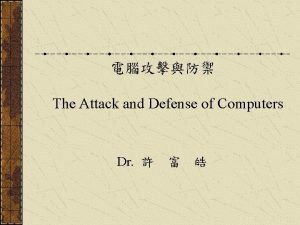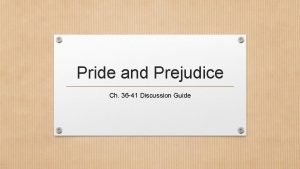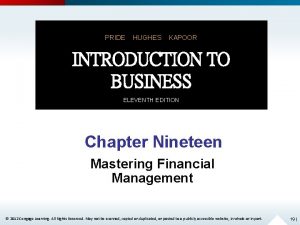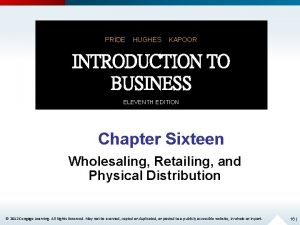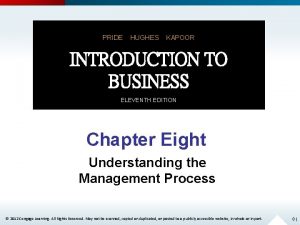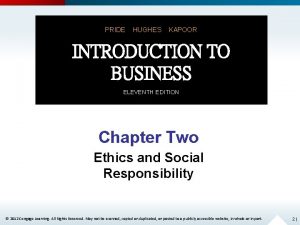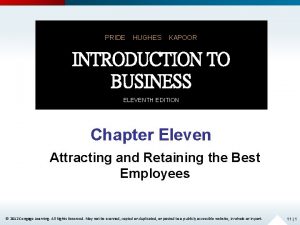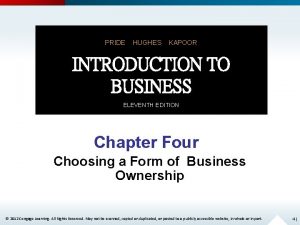Pride I Hughes I Kapoor Chapter 3 Exploring


















- Slides: 18

Pride I Hughes I Kapoor Chapter 3 Exploring Global Business Power. Point Presentation by Charlie Cook Copyright © by©Houghton Mifflin Company. All rights reserved. Copyright by Houghton Mifflin Company. All rights reserved. Seventh Edition

The Extent of International Business • International trade has tripled since World War II and now accounts for 21% of global income. – Trade barriers are decreasing, more competitors are entering the global marketplace, creating more choices for consumers. • The world economic outlook for trade – Global economic growth is predicted to be 3. 5 to 4 percent annually for the next two decades. – World production of goods and services will double by 2020. – Inflation is slowing in almost all regions of the world, especially in the developing nations. Copyright © by Houghton Mifflin Company. All rights reserved. 2

U. S. International Trade in Goods 1, 100 If a country imports more goods than it exports, the balance of trade is negative, as it was in the United States in 1999. 1, 000 900 800 Billions of dollars 700 600 Imports 500 400 Exports 300 200 100 0 – 100 – 200 Balance – 300 – 400 1985 ’ 86 ’ 87 ’ 88 ’ 89 ’ 90 ’ 91 ’ 92 ’ 93 ’ 94 ’ 95 Source: U. S. Department of Commerce, International Trade Administration, http: //www. ita. doc. gov/td/industry/otea/usfth/aggregate/H 99 t 01. txt, May 15, 2000. Copyright © by Houghton Mifflin Company. All rights reserved. ’ 96 ’ 97 ’ 98 ’ 99 Figure 3. 2 3

Exports as Percentage of GDP 14% Exports as a percentage of U. S. GDP have increased from less than 6 percent in 1970 to 12 percent today. Percent of GDP 12% 10% 8% 6% 4% 1970 1974 1978 1982 1986 Source: U. S. Department of Commerce; and the Federal Reserve Bank of St. Louis, February 2000. Copyright © by Houghton Mifflin Company. All rights reserved. 1990 1994 1998 1999 Figure 3. 7 4

Value of U. S. Merchandise Exports and Imports, 1999 Source: U. S. Department of Commerce, International Trade Administration, http: //www. ita. doc. gov/td/industry/otea/usfth/aggregate/H 99 t 06. txt, May 20, 2000. Copyright © by Houghton Mifflin Company. All rights reserved. Table 3. 1 5

U. S. Goods Export and Import Shares in 1999* GOODS EXPORT SHARES, 1999 Japan 8. 41% Canada 24. 33% Germany 3. 92% UK 5. 61% France 2. 76% Other OECD 17. 51% Mexico 12. 71% All other 24. 74% Germany 5. 35% *About 46 percent of our exports and 43 percent of our imports in 1999 were from our three leading trading partners: Canada, Mexico, and Japan. GOODS IMPORT SHARES, 1999 Japan 12. 75% Canada 19. 25% Mexico 10. 65% UK 3. 80% France 2. 51% Other OECD 12. 96% Source: The Federal Reserve Bank of St. Louis, National Economic Trends, April 2000, p. 18. Copyright © by Houghton Mifflin Company. All rights reserved. All other 32. 73% Figure 3. 8 6

Methods of Entering International Business • Licensing – A contractual agreement in which one firm permits another to produce and market its product and use its brand name in return for a royalty or other compensation. – The advantage of licensing is that it allows expansion into foreign markets with little or no direct investment. • Exporting – The process of manufacturing products in a home country and exporting them for sale in foreign markets. – Products may be sold through an export/import merchant who assumes the risks of ownership, distribution, and sale. – Letters of credit and bills of lading are used to ensure payment to the seller and delivery of the goods to the buyer. Copyright © by Houghton Mifflin Company. All rights reserved. 7

Methods of Entering International Business (cont’d) • Joint Ventures – A partnership formed to achieve a specific goal or to operate for a specific time. – Advantages of a joint venture are immediate market knowledge and access, reduced risk, and control over the product attributes. – Disadvantages of a joint venture are the complexity of establishing agreements across national borders and the high level of commitment required of all parties involved. Copyright © by Houghton Mifflin Company. All rights reserved. 8

Methods of Entering International Business (cont’d) • Totally Owned Facilities – The firm may develop in-country production and marketing facilities to serve foreign markets. – The advantage of direct investment is that it provides complete control over operations. – The disadvantage of direct investment is that the risk is greater than that of a joint venture. – Direct investment can take two forms: • Building new facilities in the foreign country. • Purchasing an existing firm in the foreign country. Copyright © by Houghton Mifflin Company. All rights reserved. 9

Methods of Entering International Business (cont’d) • Strategic Alliances – Partnerships formed to create competitive advantage on a worldwide basis. • Trading Companies – Firm that specialize in providing a link between buyers and sellers in different countries by taking title to products and performing all the activities necessary to move the products from one country to another. • Countertrade – An international barter transaction that avoids restrictions on converting domestic currency to foreign currency by the direct exchange of different goods and services between the trading partners. Copyright © by Houghton Mifflin Company. All rights reserved. 10

The Ten Largest Foreign and U. S. Multinational Corporations Source: http: //www. forbes. com. Copyright © by Houghton Mifflin Company. All rights reserved. Table 3. 5 11

Steps in Entering International Markets Copyright © by Houghton Mifflin Company. All rights reserved. Table 3. 6 a 12

Steps in Entering International Markets (cont’d) Table 3. 6 b Copyright © by Houghton Mifflin Company. All rights reserved. 13

Steps in Entering International Markets (cont’d) Source: U. S. Department of Commerce, International Trade Administration, Washington, D. C. Copyright © by Houghton Mifflin Company. All rights reserved. Table 3. 6 c 14

The General Agreement on Tariffs and Trade and the World Trade Organization • General Agreement on Tariffs and Trade (GATT) – An international organization of 132 nations dedicated to reducing or eliminating tariffs and other trade barriers to world trade. – Most-favored-nation status (MFN)—Each member of GATT was to be treated equally by all other members. Tariff reductions to be applied equally to all members. • World Trade Organization (WTO) – Created in the Uruguay Round of GATT negotiation as a successor to GATT. – WTO oversees GATT provisions and has judicial powers to meditate trade disputes arising from GATT rules. Copyright © by Houghton Mifflin Company. All rights reserved. 15

Types of Trade Restrictions • Import duty (tariff) – A tax levied on a particular foreign product entering a country. • Revenue tariffs are imposed to generate income for the government. • Protective tariffs are imposed to protect a domestic industry by keeping the prices of imports at or above the price of domestic products. • Dumping – The exportation of large quantities of a product at a price lower than that of the same product in the home market. Copyright © by Houghton Mifflin Company. All rights reserved. 16

Types of Trade Restrictions (cont’d) • Nontariff barriers – Nontax measures imposed by a government to favor domestic over foreign suppliers. – Import quota—a limit on the amount of a particular good that may be imported during a given time. – Embargo—a complete halt to trading with a particular nation or in a particular product. – Foreign exchange control—a restriction on the amount of a particular foreign currency that can be purchased or sold. – Currency devaluation—the reduction of the value of a nation’s currency relative to the currencies of other nations. – Bureaucratic red tape—a subtle form of trade restriction that imposes unnecessarily burdensome and complex standards and requirements for imported goods. Copyright © by Houghton Mifflin Company. All rights reserved. 17

Trade Restrictions Reasons for Trade Restrictions • To equalize a nation’s balance of payments. • To protect new or weak industries. • To protect national security. • To protect the health of citizens. • To retaliate for another country’s trade restrictions. Copyright © by Houghton Mifflin Company. All rights reserved. Reasons against Trade Restrictions • Higher prices for consumers. • Restriction of consumers’ choice. • Misallocation of international resources. • Loss of jobs. 18
 Shray kapoor
Shray kapoor Somya kapoor
Somya kapoor Define sreyas
Define sreyas Meriel hughes
Meriel hughes Pride and prejudice chapter 18
Pride and prejudice chapter 18 What chapter does volume 3 of pride and prejudice start
What chapter does volume 3 of pride and prejudice start Pride and prejudice chapter 36
Pride and prejudice chapter 36 Pride and prejudice chapter 49 summary
Pride and prejudice chapter 49 summary Tiffany segura
Tiffany segura Pride and prejudice chapter 30 summary
Pride and prejudice chapter 30 summary Chapter 26 exploring the universe answers
Chapter 26 exploring the universe answers Exploring religions chapter 4 large
Exploring religions chapter 4 large Physical development
Physical development Exploring globalization textbook pdf chapter 11
Exploring globalization textbook pdf chapter 11 Religion
Religion Exploring the religions of our world chapter 1 pdf
Exploring the religions of our world chapter 1 pdf Exploring religions chapter 6 large
Exploring religions chapter 6 large Exploring religions chapter 5 large
Exploring religions chapter 5 large Displaying and summarizing quantitative data
Displaying and summarizing quantitative data
